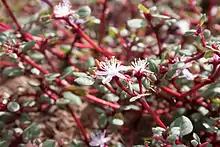Trianthema portulacastrum
Trianthema portulacastrum is a species of flowering plant in the ice plant family known by the common names desert horsepurslane,[1] black pigweed, and giant pigweed.[2] It is native to areas of several continents, including Africa and North and South America, and present as an introduced species in many other areas. It grows in a wide variety of habitat types and it can easily take hold in disturbed areas and cultivated land as a weed. It is an annual herb forming a prostrate mat or clump with stems up to a meter long. It is green to red in color, hairless except for small lines of hairs near the leaves, and fleshy. The leaves have small round or oval blades up to 4 centimeters long borne on short petioles. Solitary flowers occur in leaf axils. The flower lacks petals but has purple, petallike sepals. The fruit is a curved, cylindrical capsule emerging from the stem. It is up to half a centimeter long and has two erect, pointed wings on top, where the capsule opens.
| Trianthema portulacastrum | |
|---|---|
 | |
| Scientific classification | |
| Kingdom: | Plantae |
| Clade: | Tracheophytes |
| Clade: | Angiosperms |
| Clade: | Eudicots |
| Order: | Caryophyllales |
| Family: | Aizoaceae |
| Genus: | Trianthema |
| Species: | T. portulacastrum |
| Binomial name | |
| Trianthema portulacastrum | |
Seed dispersal occurs in a number of ways. One seed may be carried on the detached cap of the fruit, which floats on water. Other seeds may fall out of the remaining part of the fruit or remain on the plant after it dies and withers, resprouting the following season.[3]
This species is a host plant for the beet leafhopper (Circulifer tenellus).[3]
| Wikimedia Commons has media related to Trianthema portulacastrum. |
References
- "Trianthema portulacastrum". Natural Resources Conservation Service PLANTS Database. USDA. Retrieved 14 December 2015.
- "Trianthema portulacastrum". Germplasm Resources Information Network (GRIN). Agricultural Research Service (ARS), United States Department of Agriculture (USDA). Retrieved 21 January 2018.
- Trianthema portulacastrum. Flora of North America.